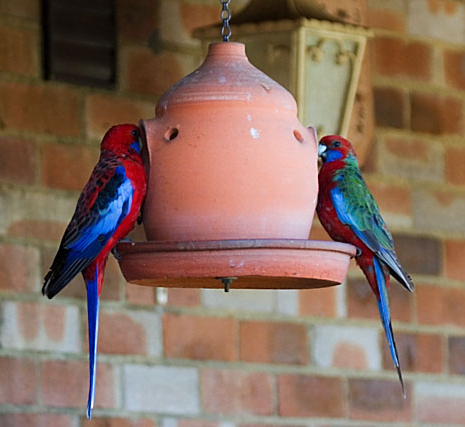 Among the parrots we find some of the world’s most flamboyantly colored birds – none more so than the spectacular Rosellas. Also known as Long-Tailed Parakeets, most Rosellas sport plumage that is difficult to describe in words – their “screaming” colors must be seen. Today we’ll take a look at a few popular species – the Eastern, Western, Northern and Crimson Rosellas.
Among the parrots we find some of the world’s most flamboyantly colored birds – none more so than the spectacular Rosellas. Also known as Long-Tailed Parakeets, most Rosellas sport plumage that is difficult to describe in words – their “screaming” colors must be seen. Today we’ll take a look at a few popular species – the Eastern, Western, Northern and Crimson Rosellas.
General Notes – Rosellas as Pets
Rosellas have pleasant, somewhat melodious calls, and their voices lack the shrill tones common to many other parrots. They are not known for extensive vocabularies, but usually pick up a few words, and are quite skilled at mimicking songs and whistles.
Averaging 12 inches in length, Rosellas are active and delight in flying, and so are best housed in large cages and given frequent out-of-cage time. An outdoor aviary is ideal. Many species are very cold tolerant, but I have run across frost-damaged toes in zoo collections, so caution is required during cooler seasons.
Rosella appetites are easy to accommodate – most do well on a mix of cockatiel seed, pellets and finch seed, along with fruits, vegetables and sprouts. A few have special preferences (i.e. earthworms for the Crimson Rosella) – please write in for details.
Many Rosellas breed well in captivity, and a number of color strains have been produced (not that their colors need any enhancement!). Males bow and whistle when courting, and the pair will feed one-another once interest is aroused. They usually make good parents; the young fledge in approximately 6 weeks and should be removed shortly thereafter to prevent male-male aggression.
Eastern or Golden Mantled Rosella, Platycercus eximius
Bright red, yellow, green, blue, white and black all make their appearance in this stunningly beautiful bird’s plumage. Gorgeous as they are, Eastern Rosellas are considered crop pests on farms and orchards (hard for non-Australians to picture, I know!).
Eastern Rosellas favor lightly-wooded areas, and often forage on the ground. They are native to Southeastern Australia and Tasmania, and have been introduced to New Zealand.
Crimson Rosella, Platycercus elegans
 This was the first Rosella that I kept, and it hooked me (and countless others!) on the group. Its indescribably bright red feathers are set off by sky blue on the throat, wings and tail.
This was the first Rosella that I kept, and it hooked me (and countless others!) on the group. Its indescribably bright red feathers are set off by sky blue on the throat, wings and tail.
Crimson Rosellas are found in Eastern and Southeastern Australia, and have been introduced to New Zealand. Like most Rosellas, they can be quite personable, affectionate companions, but do not like being restrained. Insects figure importantly in their diets, with earthworms being a favored nestling food.
Western or Stanley’s Rosella, Platycercus icterotis
A bright red head, throat and breast highlighted by yellow cheeks, a green back and flight feathers that are blue-black above and light blue below – what more can I say…this bird must be seen to be believed (please see video below)!
Ranging across Southwestern Australia, the Western Rosella favors wooded grasslands and sometimes colonizes parks and gardens (imagine this as a “backyard bird”!).
Northern or Brown’s Rosella, Platycercus venustus
This beauty hails from Northwestern Australia and nearby islands. Its yellow-banded blue and black feathers leave a lasting impression on even the most casual of observers.
Northern Rosellas frequent open woodlands, and often occur near rivers, marshes and mangrove swamps.
Further Reading
Research Update: Crimson Rosellas Use Unique Chick-Rearing Strategy.
Western Rosella image referenced from wikipedia and originally posted by Robert Young and Snowmanradio
Crimson Rosellas image referenced from wikipedia and originally posted by Mfunnell and Snowmanradio
 That Bird Blog – Bird Care and History for Pet Birds
That Bird Blog – Bird Care and History for Pet Birds




Hello Frank, I love the Rosellas, The stories are great that you write and send out to all of us.
Hello Linda, Frank Indiviglio here.
Thanks so much for the kind words; I look forward to your comments and questions, and glad to hear that you are enjoying the articles.
Good luck, enjoy and please keep me posted.
Best regards, Frank Indiviglio.